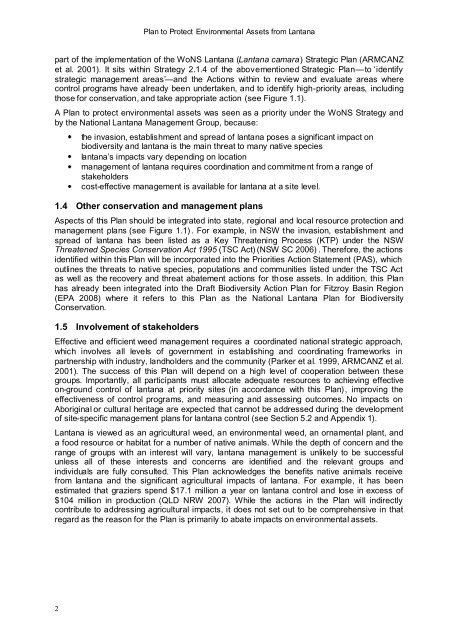Plan to Protect Environmental Assets from Lantana - Weeds Australia
Plan to Protect Environmental Assets from Lantana - Weeds Australia
Plan to Protect Environmental Assets from Lantana - Weeds Australia
Create successful ePaper yourself
Turn your PDF publications into a flip-book with our unique Google optimized e-Paper software.
<strong>Plan</strong> <strong>to</strong> <strong>Protect</strong> <strong>Environmental</strong> <strong>Assets</strong> <strong>from</strong> <strong>Lantana</strong><br />
part of the implementation of the WoNS <strong>Lantana</strong> (<strong>Lantana</strong> camara) Strategic <strong>Plan</strong> (ARMCANZ<br />
et al. 2001). It sits within Strategy 2.1.4 of the abovementioned Strategic <strong>Plan</strong>—<strong>to</strong> ‘identify<br />
strategic management areas’—and the Actions within <strong>to</strong> review and evaluate areas where<br />
control programs have already been undertaken, and <strong>to</strong> identify high-priority areas, including<br />
those for conservation, and take appropriate action (see Figure 1.1).<br />
A <strong>Plan</strong> <strong>to</strong> protect environmental assets was seen as a priority under the WoNS Strategy and<br />
by the National <strong>Lantana</strong> Management Group, because:<br />
the invasion, establishment and spread of lantana poses a significant impact on<br />
biodiversity and lantana is the main threat <strong>to</strong> many native species<br />
lantana’s impacts vary depending on location<br />
management of lantana requires coordination and commitment <strong>from</strong> a range of<br />
stakeholders<br />
cost-effective management is available for lantana at a site level.<br />
1.4 Other conservation and management plans<br />
Aspects of this <strong>Plan</strong> should be integrated in<strong>to</strong> state, regional and local resource protection and<br />
management plans (see Figure 1.1) . For example, in NSW the invasion, establishment and<br />
spread of lantana has been listed as a Key Threatening Process (KTP) under the NSW<br />
Threatened Species Conservation Act 1995 (TSC Act) (NSW SC 2006) . Therefore, the actions<br />
identified within this <strong>Plan</strong> will be incorporated in<strong>to</strong> the Priorities Action Statement (PAS), which<br />
outlines the threats <strong>to</strong> native species, populations and communities listed under the TSC Act<br />
as well as the recovery and threat abatement actions for those assets. In addition, this <strong>Plan</strong><br />
has already been integrated in<strong>to</strong> the Draft Biodiversity Action <strong>Plan</strong> for Fitzroy Basin Region<br />
(EPA 2008) where it refers <strong>to</strong> this <strong>Plan</strong> as the National <strong>Lantana</strong> <strong>Plan</strong> for Biodiversity<br />
Conservation.<br />
1.5 Involvement of stakeholders<br />
Effective and efficient weed management requires a coordinated national strategic approach,<br />
which involves all levels of government in establishing and coordinating frameworks in<br />
partnership with industry, landholders and the community (Parker et al. 1999, ARMCANZ et al.<br />
2001). The success of this <strong>Plan</strong> will depend on a high level of cooperation between these<br />
groups. Importantly, all participants must allocate adequate resources <strong>to</strong> achieving effective<br />
on-ground control of lantana at priority sites (in accordance with this <strong>Plan</strong>), improving the<br />
effectiveness of control programs, and measuring and assessing outcomes. No impacts on<br />
Aboriginal or cultural heritage are expected that cannot be addressed during the development<br />
of site-specific management plans for lantana control (see Section 5.2 and Appendix 1).<br />
<strong>Lantana</strong> is viewed as an agricultural weed, an environmental weed, an ornamental plant, and<br />
a food resource or habitat for a number of native animals. While the depth of concern and the<br />
range of groups with an interest will vary, lantana management is unlikely <strong>to</strong> be successful<br />
unless all of these interests and concerns are identified and the relevant groups and<br />
individuals are fully consulted. This <strong>Plan</strong> acknowledges the benefits native animals receive<br />
<strong>from</strong> lantana and the significant agricultural impacts of lantana. For example, it has been<br />
estimated that graziers spend $17.1 million a year on lantana control and lose in excess of<br />
$104 million in production (QLD NRW 2007). While the actions in the <strong>Plan</strong> will indirectly<br />
contribute <strong>to</strong> addressing agricultural impacts, it does not set out <strong>to</strong> be comprehensive in that<br />
regard as the reason for the <strong>Plan</strong> is primarily <strong>to</strong> abate impacts on environmental assets.<br />
2

















